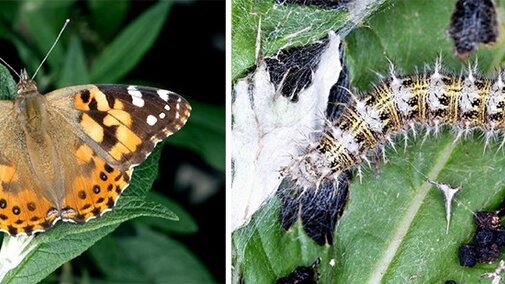In 2017 large populations of painted lady butterflies were seen across the state, raising concerns about whether the larvae form (thistle caterpillars) of this insect would cause damage to soybean fields.
Growers should not apply pesticides to control painted lady butterflies; however, they should scout soybeans fields for leaf defoliation from thistle caterpillars and other insects.

- Painted lady butterflies lay single eggs on soybean plants with eggs hatching in about seven days.
- After hatching, larvae will feed for two to four weeks with 97% of their consumption occurring in the last two larval instars.
- Larvae are typically found in the upper canopy with damaged plants usually occurring at the edge of a field.
- The larvae form webs by tying leaves together, creating a protective area there they can feed.
- Larvae will pupate over a period of 7-17 days with approximately two generations per year in the Midwest.
- An accurate estimation of soybean defoliation is critical for determining if an insecticide application is necessary.
- Insecticide applications can be made when defoliation exceeds 30% in the vegetative stage and 20% in the reproductive stage.

- Painted lady or thistle caterpillars are found on over 100 plant species, including
- soybeans,
- cocklebur,
- canada Thistle,
- sunflowers,
- aster,
- ironweed, and
- red clover.
More information can be found in the NebGuide, Managing Soybean Defoliators (G2259).

